#Philosophy Museum
Explore tagged Tumblr posts
Text

母と一緒に西田幾多郎記念哲学館を訪れました。哲学の道は緑豊かで秋の訪れを感じながら一歩一歩歩きました。
I had the opportunity to visit the Museum of Philosophy dedicated to Japanese philosopher Kitaro Nishida in Ishikawa with my family. Inspired by a Shogakukan children's manga my daughter read about his life, she expressed a keen interest in exploring his philosophy further. Together with her grandmother, we engaged in thoughtful discussions and discovered the intriguing concepts that shaped Nishida's ideas. It was a meaningful experience that brought us closer as a family while deepening our understanding of philosophy.
日本語はこちら
#Kitaro Nishida#Philosophy#Philosophy Museum#Ishikawa#Japanese philosophy#Museum of Philosophy#西田哲学#山田なつみ#西田幾多郎#哲学の道#original photographers#photography#photographers on tumblr#photodiary#ordinaryphoto but a special moment
1 note
·
View note
Text

Life is art. Art is life. I never separate it.
#dark academia#romanticism#dark acadamia aesthetic#romantic academia#aestethic#dark academia vibes#beauty#poetry#thoughts#philosophy#books & libraries#books#bookblr#old aesthetic#academia aesthetic#light academia#chaotic academia#passion#museum#art academia#art#love aesthetic#lovers#quotes#dark core gothique
784 notes
·
View notes
Text

Marble head of the philosopher Epicurus (341-270 BCE), known for his materialistic theory of the universe and his belief in pleasure as the goal (telos) of human life. Roman copy of the 2nd century CE, after a lost Greek original of the first half of the 3rd century BCE. Now in the Metropolitan Museum of Art.
#classics#tagamemnon#history#ancient history#ancient philosophy#Epicurus#art#art history#ancient art#Greek art#Ancient Greek art#Hellenistic period#Hellenistic art#sculpture#portrait sculpture#marble#stonework#Metropolitan Museum of Art
158 notes
·
View notes
Text
April 14, Xi'an, China, Shaanxi History Museum, Qin and Han Dynasties Branch (Part 3 – Innovations and Philosophies):
(Edit: sorry this post came out so late, I got hit by the truck named life and had to get some rest, and this post in itself took some effort to research. But anyway it's finally up, please enjoy!)
A little background first, because this naming might lead to some confusions.....when you see location adjectives like "eastern", "western", "northern", "southern" added to the front of Zhou dynasty, Han dynasty, Song dynasty, and Jin/晋 dynasty, it just means the location of the capital city has changed. For example Han dynasty had its capital at Chang'an (Xi'an today) in the beginning, but after the very brief but not officially recognized "Xin dynasty" (9 - 23 AD; not officially recognized in traditional Chinese historiography, it's usually seen as a part of Han dynasty), Luoyang became the new capital. Because Chang'an is geographically to the west of Luoyang, the Han dynasty pre-Xin is called Western Han dynasty (202 BC - 8 AD), and the Han dynasty post-Xin is called Eastern Han dynasty (25 - 220 AD). As you can see here, in these cases this sort of adjective is simply used to indicate different time periods in the same dynasty.
Model of a dragonbone water lift/龙骨水车, Eastern Han dynasty. This is mainly used to push water up to higher elevations for the purpose of irrigation:
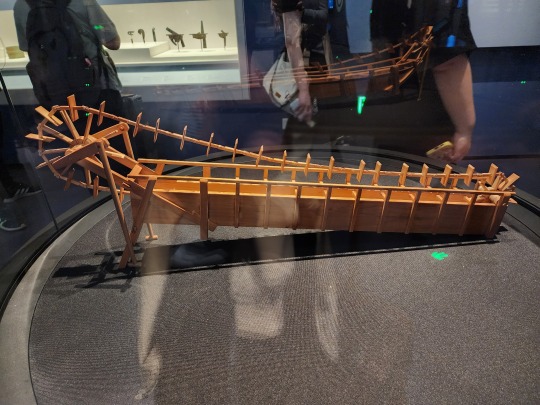
Model of a water-powered bellows/冶铁水排, Eastern Han dynasty. Just as the name implies, as flowing water pushes the water wheel around, the parts connected to the axle will pull and push on the bellows alternately, delivering more air to the furnace for the purpose of casting iron.
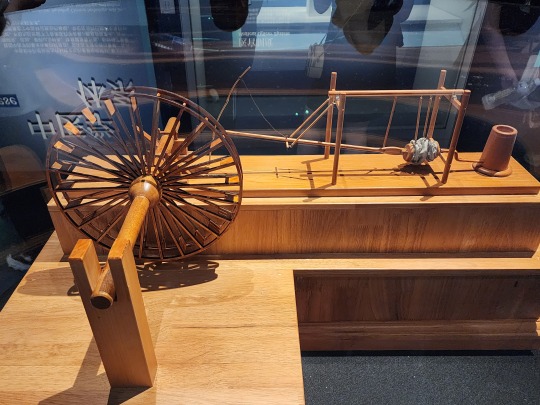
The Nine Chapters on the Mathematical Art/《九章算术》, Fangcheng/方程 chapter. It’s a compilation of the work of many scholars from 10 th century BC until 2 nd century AD, and while the earliest authors are unknown, it has been edited and supplemented by known scholars during Western Han dynasty (also when the final version of this book was compiled), then commented on by scholars during Three Kingdoms period (Kingdom of Wei) and Tang dynasty. The final version contains 246 example problems and solutions that focus on practical applications, for example measuring land, surveying land, construction, trading, and distributing taxes. This focus on practicality is because it has been used as a textbook to train civil servants. Note that during Han dynasty, fangcheng means the method of solving systems of linear equations; today, fangcheng simply means equation. For anyone who wants to know a little more about this book and math in ancient China, here’s an article about it. (link goes to pdf)

Diagram of a circle in a right triangle (called “勾股容圆” in Chinese), from the book Ceyuan Haijing/《测圆海镜》 by Yuan-era mathematician Li Ye/李冶 (his name was originally Li Zhi/李治) in 1248. Note that Pythagorean Theorem was known by the name Gougu Theorem/勾股定理 in ancient China, where gou/勾 and gu/股 mean the shorter and longer legs of the right triangle respectively, and the hypotenuse is named xian/弦 (unlike what the above linked article suggests, this naming has more to do with the ancient Chinese percussion instrument qing/磬, which is shaped similar to a right triangle). Gougu Theorem was recorded in the ancient Chinese mathematical work Zhoubi Suanjing/《周髀算经》, and the name Gougu Theorem is still used in China today.
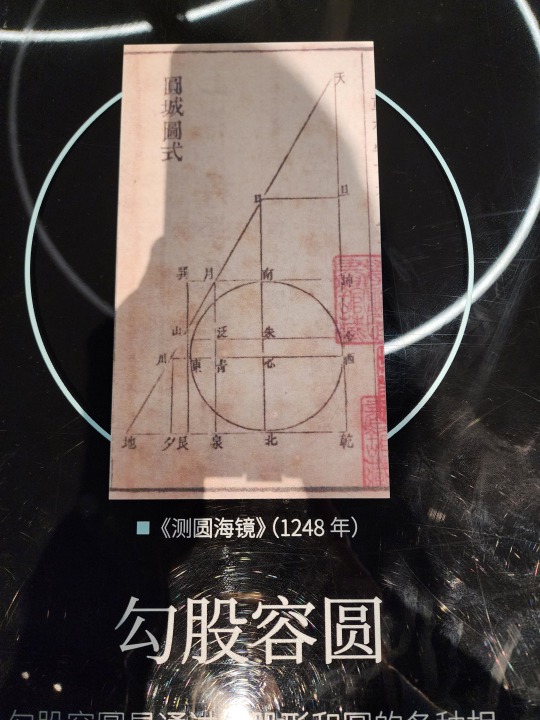
Diagram of the proof for Gougu Theorem in Zhoubi Suanjing. The sentence on the left translates to "gou (shorter leg) squared and gu (longer leg) squared makes up xian (hypotenuse) squared", which is basically the equation a² + b² = c². Note that the character for "squared" here (mi/幂) means "power" today.

This is a diagram of Zhang Heng’s seismoscope, called houfeng didong yi/候风地动仪 (lit. “instrument that measures the winds and the movements of the earth”). It was invented during Eastern Han dynasty, but no artifact of houfeng didong yi has been discovered yet, this is presumably due to constant wars at the end of Eastern Han dynasty. All models and diagrams that exist right now are what historians and seismologists think it should look like based on descriptions from Eastern Han dynasty. This diagram is based on the most popular model by Wang Zhenduo that has an inverted column at the center, but this model has been widely criticized for its ability to actually detect earthquakes. A newer model that came out in 2005 with a swinging column pendulum in the center has shown the ability to detect earthquakes, but has yet to demonstrate ability to reliably detect the direction where the waves originate, and is also inconsistent with the descriptions recorded in ancient texts. What houfeng didong yi really looks like and how it really works remains a mystery.
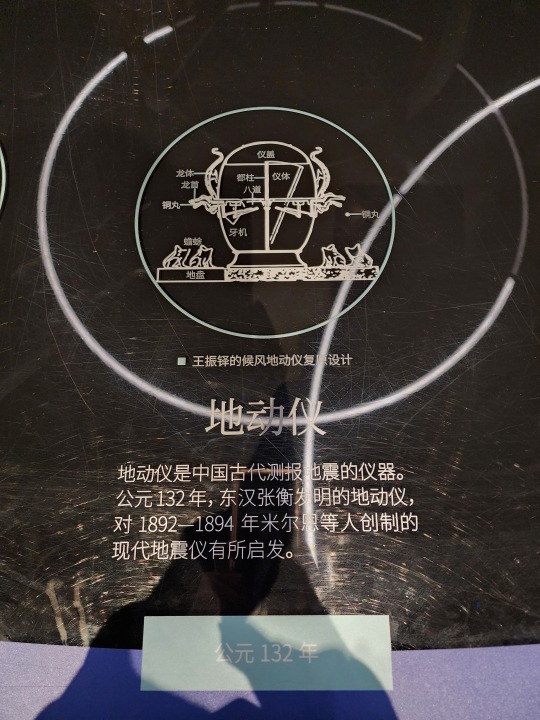
Xin dynasty bronze calipers, the earliest sliding caliper found as of now (not the earliest caliper btw). This diagram is the line drawing of the actual artifact (right).
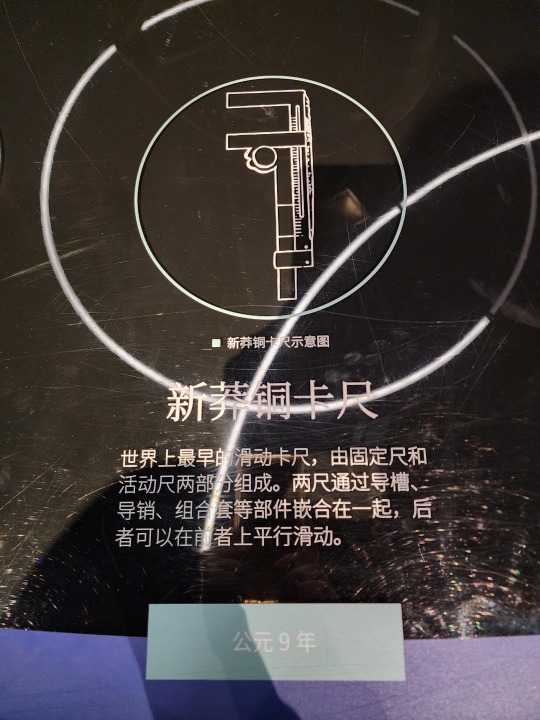

Ancient Chinese "Jacquard" loom (called 提花机 or simply 花机 in Chinese, lit. "raise pattern machine"), which first appeared no later than 1st century BC. The illustration here is from the Ming-era (1368 - 1644) encyclopedia Tiangong Kaiwu/《天工开物》. Basically it's a giant loom operated by two people, the person below is the weaver, and the person sitting atop is the one who controls which warp threads should be lifted at what time (all already determined at the designing stage before any weaving begins), which creates patterns woven into the fabric. Here is a video that briefly shows how this type of loom works (start from around 1:00). For Hanfu lovers, this is how zhuanghua/妆花 fabric used to be woven, and how traditional silk fabrics like yunjin/云锦 continue to be woven. Because it is so labor intensive, real jacquard silk brocade woven this way are extremely expensive, so the vast majority of zhuanghua hanfu on the market are made from machine woven synthetic materials.
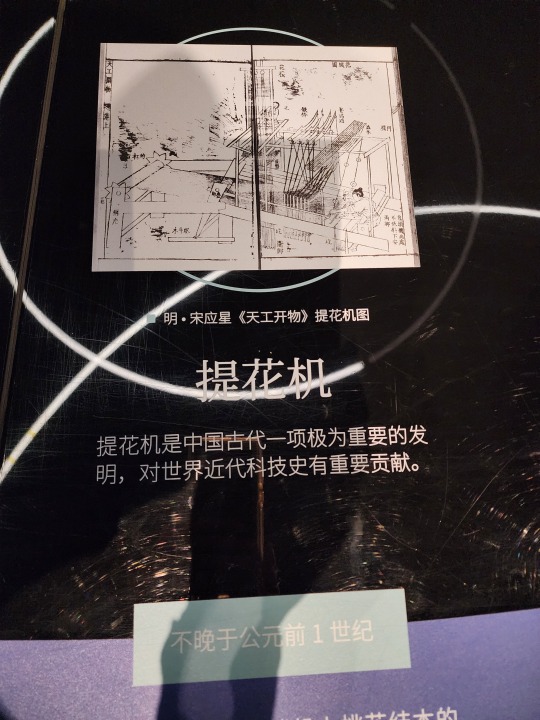
Chinese purple is a synthetic pigment with the chemical formula BaCuSi2O6. There's also a Chinese blue pigment. If anyone is interested in the chemistry of these two compounds, here's a paper on the topic. (link goes to pdf)

A list of common colors used in Qin and Han dynasties and the pigments involved. White pigment comes from chalk, lead compounds, and powdered sea shells; green pigment comes from malachite mineral; blue pigment usually comes from azurite mineral; black comes from pine soot and graphite; red comes from cinnabar; ochre comes from hematite; and yellow comes from realgar and orpiment minerals.
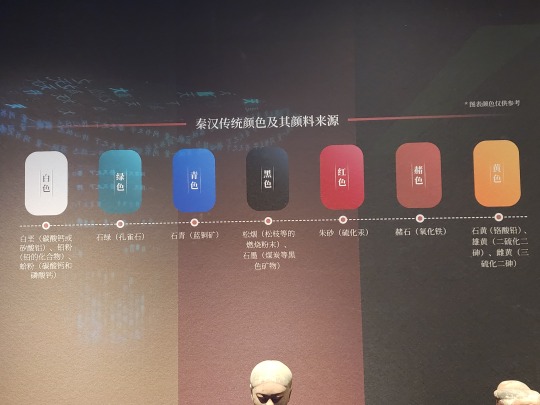
Also here are names of different colors and shades during Han dynasty. It's worth noting that qing/青 can mean green (ex: ���草, "green grass"), blue (ex: 青天, "blue sky"), any shade between green and blue, or even black (ex: 青丝, "black hair") in ancient Chinese depending on the context. Today 青 can mean green, blue, and everything in between.
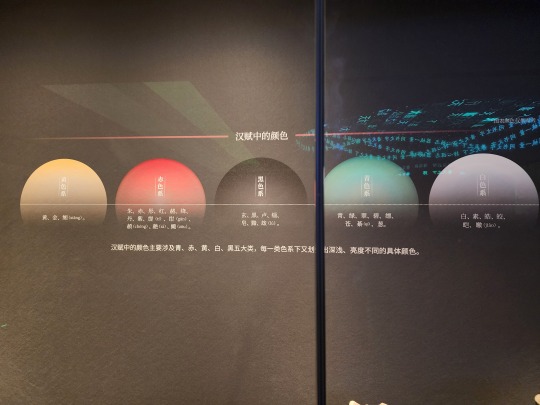
Western Han-era bronze lamp shaped like a goose holding a fish in its beak. This lamp is interesting as the whole thing is hollow, so the smoke from the fire in the lamp (the fish shaped part) will go up into the neck of the goose, then go down into the body of the goose where there's water to catch the smoke, this way the smoke will not be released to the surrounding environment. There are also other lamps from around the same time designed like this, for example the famous gilt bronze lamp that's shaped like a kneeling person holding a lamp.
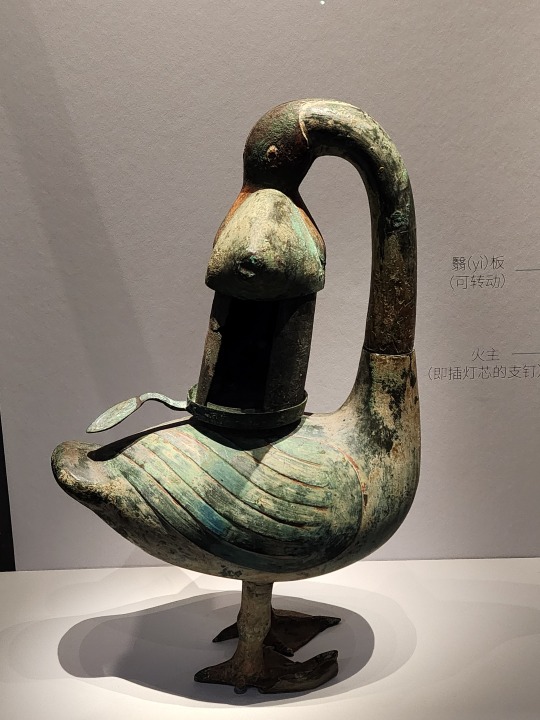
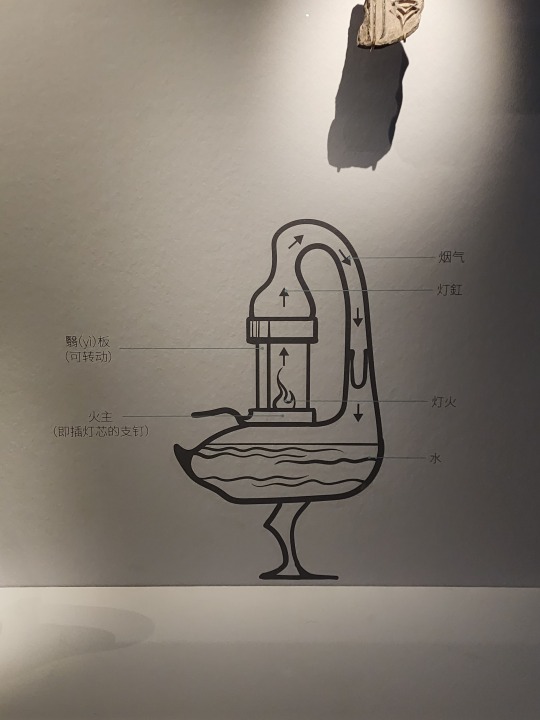
Part of a Qin-era (?) clay drainage pipe system:
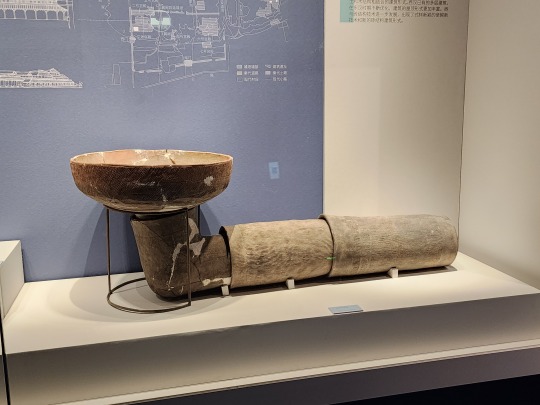
A list of canals that was dug during Warring States period, Qin dynasty, and pre-Emperor Wu of Han Han dynasty (475 - 141 BC). Their purposes vary from transportation to irrigation. The name of the first canal on the list, Hong Gou/鸿沟, has already become a word in Chinese language, a metaphor for a clear separation that cannot be crossed (ex: 不可逾越的鸿沟, meaning "a gulf that cannot be crossed").

Han-era wooden boat. This boat is special in that its construction has clear inspirations from the ancient Romans, another indication of the amount of information exchange that took place along the Silk Road:
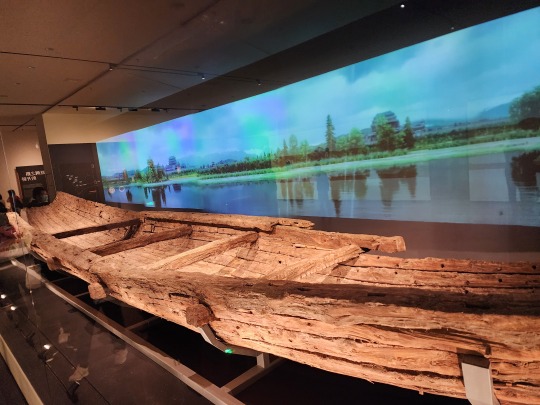
A model that shows how the Great Wall was constructed in Qin dynasty. Laborers would use bamboo to construct a scaffold (bamboo scaffolding is still used in construction today btw, though it's being gradually phased out) so people and materials (stone bricks and dirt) can get up onto the wall. Then the dirt in the middle of the wall would be compressed into rammed earth, called hangtu/夯土. A layer of stone bricks may be added to the outside of the hangtu wall to protect it from the elements. This was also the method of construction for many city walls in ancient China.
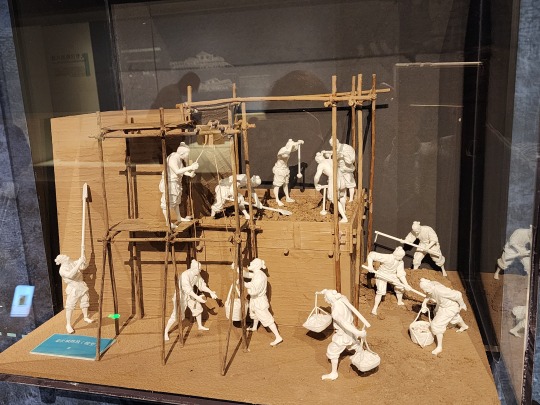
A list of the schools of thought that existed during Warring States period, their most influential figures, their scholars, and their most famous works. These include Confucianism (called Ru Jia/儒家 in Chinese; usually the suffix "家" at the end denotes a school of thought, not a religion; the suffix "教" is that one that denotes a religion), Daoism/道家, Legalism (Fa Jia/法家), Mohism/墨家, etc.

The "Five Classics" (五经) in the "Four Books and Five Classics" (四书五经) associated with the Confucian tradition, they are Shijing/《诗经》 (Classic of Poetry), Yijing/《易经》 (also known as I Ching), Shangshu/《尚书》 (Classic of History), Liji/《礼记》 (Book of Rites), and Chunqiu/《春秋》 (Spring and Autumn Annals). The "Four Books" (四书) are Daxue/《大学》 (Great Learning), Zhongyong/《中庸》 (Doctrine of the Mean), Lunyu/《论语》 (Analects), and Mengzi/《孟子》 (known as Mencius).
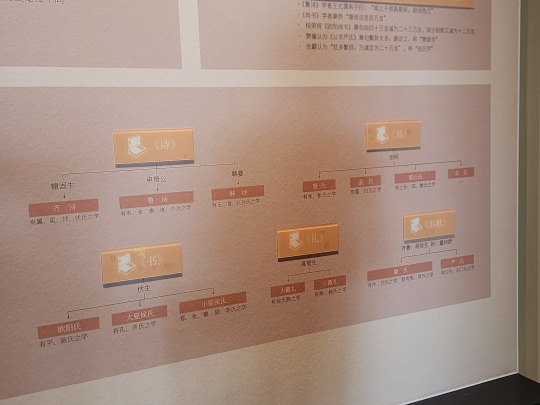
And finally the souvenir shop! Here's a Chinese chess (xiangqi/象棋) set where the pieces are fashioned like Western chess, in that they actually look like the things they are supposed to represent, compared to traditional Chinese chess pieces where each one is just a round wooden piece with the Chinese character for the piece on top:
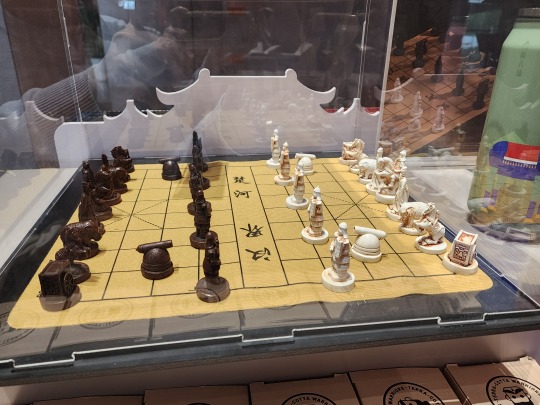
A blind box set of small figurines that are supposed to mimic Shang and Zhou era animal-shaped bronze vessels. Fun fact, in Shang dynasty people revered owls, and there was a female general named Fu Hao/妇好 who was buried with an owl-shaped bronze vessel, so that's why this set has three different owls (top left, top right, and middle). I got one of these owls (I love birds so yay!)
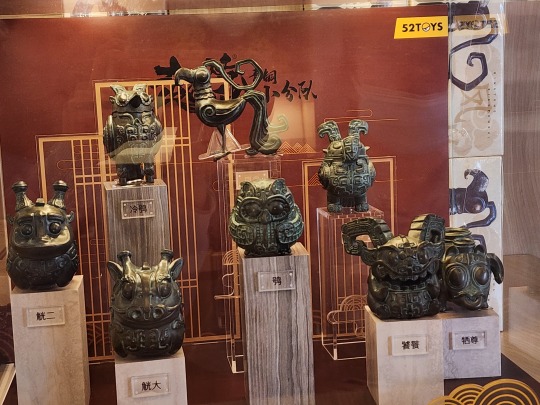
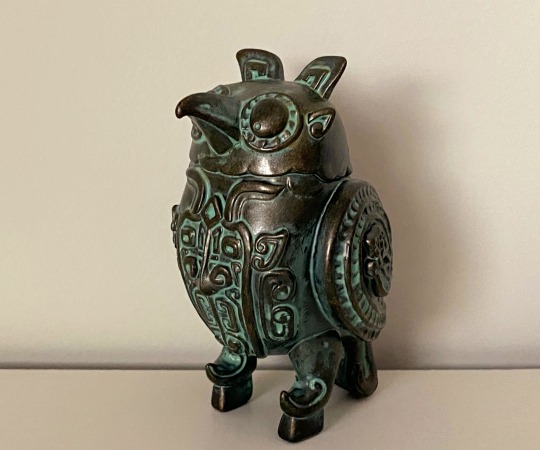
And that concludes the museums I visited while in Xi'an!
#2024 china#xi'an#china#shaanxi history museum qin and han dynasties branch#chinese history#chinese culture#chinese language#qin dynasty#han dynasty#warring states period#chinese philosophy#ancient technology#math history#history#culture#language
96 notes
·
View notes
Text

Dmitry Kochanovich - Philosophy (2019)
58 notes
·
View notes
Text


Socrates and Alcibiades, Christoffer Wilhelm Eckersberg, 1813-16
#thorvaldsen museum#socrates#alcibiades#christoffer wilhelm eckersberg#19th century#art history#art#aesthethic#painting#ancient greece#philosophy#queer history#homoerotic art#danish art
136 notes
·
View notes
Text

In his 45 B.C. book “Tusculan Disputations”, Cicero rewrites and therefore popularizes an ancient moral parable. In the roman philosopher’s version, the tyrannical king Dionysius II showed his subjects the looming danger of ruling over a city, by hanging a razor-sharp sword over Damocles’ head. Suspended only by a single strand of horsehair, it represented how death is always breathing down the neck of the ones in a position of power.
Today, to have The Damocles Sword over one's head is an idiom used to describe any situation threatening imminent harm or disaster.
Detail from Richard Westall, The Sword of Damocles, 1812, oil on canvas, 130 × 103 × 8.3 cm, Ackland Art Museum, own photograph of painting, Ackland Museum, Chapel Hill, North Carolina, United States of America
#cicero#history#linguistics#greek myth#ancient greece#ancient greek mythology#ancient greek philosophy#daily art#painting of the day#art of the day#art on tumblr#art history#museum#oil on canvas#oil painting#richard westall#19th century art#neoclassicism#daily painting#artwork#daily
23 notes
·
View notes
Text
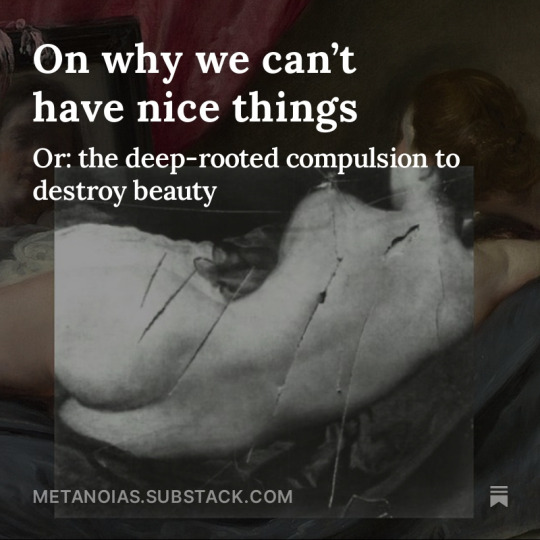
Two Just Stop Oil protesters were arrested after smashing the glass protecting the iconic Rokeby Venus by Diego Velázquez at the National Gallery in London.
The incident comes hot on the heels of several widely publicised attacks against artworks by climate activists.
Is art vandalism for ostensibly noble political purposes justified, or is there something more sinister — and indefensible — at play?
Read more here.
#art#art history#national gallery#art gallery#museum#the rokeby venus#diego velazquez#spanish art#just stop oil#climate change#climate crisis#climate action#climate and environment#climate activism#fine art#painting#philosophy
257 notes
·
View notes
Text

Philosophy and Christian Art
Artist: Daniel Huntington (American, 1816-1906)
Date: 1868
Medium: Oil on canvas
Collection: Los Angeles County Museum of Art, Los Angeles, CA, United States
Description
Although most of Huntington’s long career was taken up in painting more than one thousand portraits, he also painted landscapes and probably thought of himself as a painter of allegories and ideal subjects. His interest in religious and allegorical painting had been kindled by the Raphaelesque Italian and German ideal subjects he had seen in Rome on his first trip to Europe in 1839. By the 1860s his models were the Venetian artists of the High Renaissance, especially Titian (c. 1488-1576), whose example can be seen in the costumes and figure types depicted in Philosophy and Christian Art. The model or the type of the old man also appears in Huntington’s Sowing the Word, 1868 (New-York Historical Society). The influence of the Venetian school can also be seen in the rounder forms and richer palette of his paintings of this period. Even the half length format seems to echo Venetian examples. The model for the painting to which the young lady gestures, however, appears to be The Adoration of the Shepherds, 1650, by José Ribera (1588-1652) in the Louvre, Paris. The painting is conceived as a conversation between embodiments of opposing, but equally worthy points of view. The wisdom of the aged scholar, reading a book by lamplight, is contrasted with the intuitive perceptions of the young woman who examines a work of art by the daylight signified by the window.
#allegory#painting#oil on canvas#philosophy#christian art#artist#phillsopher#open book#artwork#woman#man#young lady#aged scholar#reading#lamplight#symbolism#window#costume#distant landscape#oil painting#daniel huntington#american painter#american art#19th century painting#los angeles county museum
22 notes
·
View notes
Text
The cosmos is within us. We are made of star-stuff. We are a way for the universe to know itself. _ Carl Sagan
#books & libraries#known#strangecore#philosophy#universe speaks#thought provoking#thoughts#museums#cosmos#space#galaxy#planet
18 notes
·
View notes
Text






all from pinterest <3
#dark academia#literature#light academia#vintage#pinterest#source: pintrest#brown#aesthetic#philosophy#museum#moodboard#dark academic aesthetic#academicism#spilled ink
27 notes
·
View notes
Text


Image: Alone with the Gods, Piccinini, 2016
Posthumanist Art
Posthumanism is an invitation to reconfigure our existence, redirect our attention, and reconnect with others (human, nonhuman, technology, and ecosystems), not in a romantic but in a responsible, engaged, respectful, and never-objectifying way...
The first philosophical traces of the radical shifts that will thereafter become known as posthumanism became visible at the end of the nineteenth century in the work of Friedrich Nietzsche, only to resurface during the second half of the last century in the poststructural work of Michele Foucault, Judith Butler, Deleuze and Guattari, and Jacques Derrida.
These philosophers were among the first to wrestle with the acknowledgment that the boundaries that define the human are a dangerous cultural construct. Their target was the blinkeredness of anthropocentrism — a byproduct of humanism: the Renaissance dogma that put humans on a pedestal and made us the measure of all things. - Flash Art

Image: The Pollinators Pavilion, Lily Landes
Flashback to 1992: curator Jeffrey Deitch traveled between Lausanne, Turin, Athens, Hamburg, and Jerusalem ( bypassing the USA and other world art capitals) with a cutting-edge exhibition of 36 avant-garde artists who were foregrounding a moment in technology culture in the early internet age when outmoded binary boundaries between subjects and objects, human and non-humans were being blurred.
The carnivalesque exhibition, Post Human showed that body improvement that celebrated artificiality was becoming the new normality: plastic surgery, diet pills, and mind-altering drugs could enhance humans beyond their wildest fantasies.
The success of the exhibition showed that art was assuming a more central role by merging with science, computerization, and biotechnology to reshape the human form and identity with an outlandish flair for embracing the artificial. The controversial message was disseminated by the European press and quickly reached the up-and-coming younger artists and art schools around the world. The adoration of the inorganic over the natural was becoming habitual to some while others felt the human race was becoming an endangered species. - White Hot Magazine




Image: To See the Earth Before the End of the World, by Precious Okoyomon
While it is a commonly accepted fact that humans are essentially animals, we continue to place ourselves in opposition to animals and other life forms. Posthumanism suggests that we should stop thinking of ourselves as superior to the rest of the planet and accept that we are part of nature...
Taking a posthuman perspective, we may start by asking a deeper question: why do we continue to associate the word ‘humane’ with lack of cruelty? After all, no animal is as cruel and destructive as the human animal. We need to take a good look in the mirror and ask ourselves whether ‘the human’ should really be used as an ethical standard.
Likewise, we must face the even more difficult ethical question of whether the preservation of the human should always be put above all else. Does the saving of human lives justify the destruction of our planet and the killing of other animals? - The Collector

Image: Post Human at Jeffrey Deitch, Los Angeles
#posthumanism#art#contemporary art#modern art#avant garde#art history#philosophy#humanities#museum aesthetic#museum#art gallery#art exhibition#surrealcore#surrealism#surreal
8 notes
·
View notes
Text
in a lost of post-canon fics ive seen, a lot of people like ryou bakura to follow in his fathers footsteps w egyptology and acheology and whatever else but in my opinion I think he would actually really enjoy social sciences, specifically, studying peoples brain and behaviour and what else. Sociology, (behavioral) Psychology, and Criminology.
I think it'd be interesting for him to think about why people behave the way they do, and what causes them to hurt others. How hurt people hurt people, and how people handle complex trauma.
#guy who is in the crim program studying a lot of trauma and system procedures#with electives in psych sociology and philosophy#sitting in class like “man i bet ryou bakura would have something to say about this”#“i don’t think the system is equipped to handle people with complex needs” I say. thinking about a certain thief.#ryou bakura#bakura ryou#yugioh#now do i think hed do anything with that kind of studies? no i think hed go work at the museum anyways. no one likes social sciences
8 notes
·
View notes
Text
A woman is born with two unchanging truths. A hunger for destruction and the burden of its suppression.
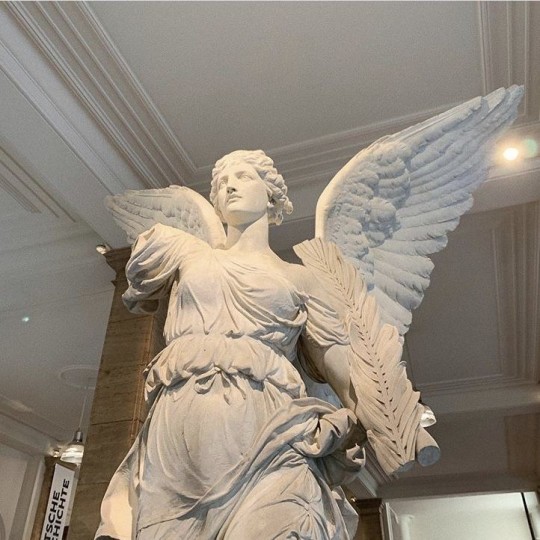
#aesthetic#dark academia#vintage#pinterest#tumblr fyp#writers on tumblr#spilled words#hell is a teenage girl#girl blogger#im going feral#half sane#poetry#literature#fypシ#art#museum#sylvia plath#philosophy#i need to be immortal basically#female insanity#female hysteria#femcel#idc idc#bring them home now#this is what makes us girls#actually mentally ill#inanimate insanity#fuck the patriarchy
45 notes
·
View notes
Text
Credits to fairouz_bfa
Have a nice day love
#dark academia#literature#tsh#dark aesthetic#the secret history#donna tartt#studyblr#coffee#q#warm and cosy#art#louvre#studyspo#spotify#philosophy thoughts#i love q more ardently#museums#classics#flowers#art inspiration
175 notes
·
View notes
Text
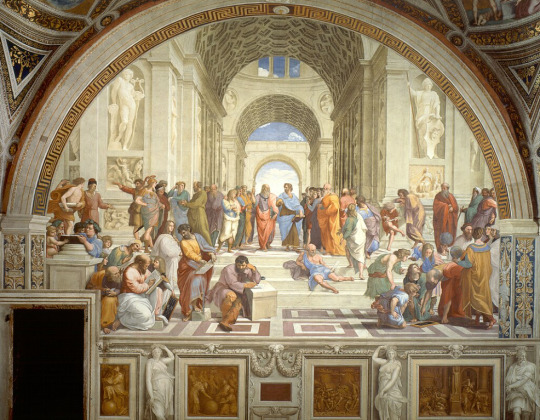

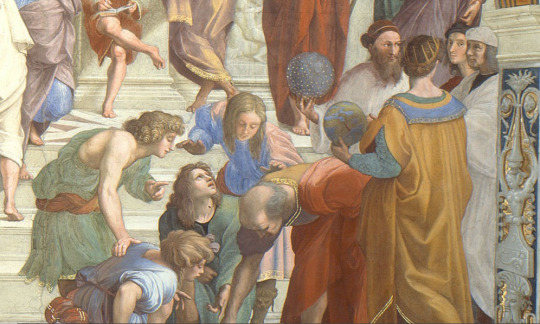
The school of Athens, Raffaello Sanzio, 1509-11
#art history#art#italian art#aesthethic#16th century#ancient greece#athens#school of athens#raffaello sanzio#raphael#philosophy#vatican museums#musei vaticani#frescoes#plato#aristotle
52 notes
·
View notes